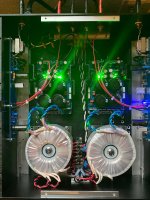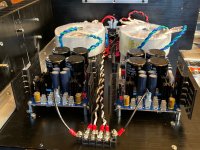Vandys like Theils before them have So Much Crossover circuit /bits that a LOT of Amp power was/is erm wasted by the crossovers.
Hmmmmmm, interesting!! You’re the first person to ever say that, but it does make sense to me. I assume it’s an effect of them being first-order crossovers?
Does this play into amp selection in any meaningful way other than simple “you need plenty of power”?
Perhaps the Model 3A needs more power than the Model 2C. I’ve never had a chance to run a pair. My 2Cs are quite happy with the VFET amp, which is only rated for 10W. It is a single ended Class A design with a bias current of 1.6A.
Perhaps the Model 3A needs more power than the Model 2C. I’ve never had a chance to run a pair. My 2Cs are quite happy with the VFET amp, which is only rated for 10W. It is a single ended Class A design with a bias current of 1.6A.
The Model 2's have a much nicer impedance graph for one thing: Vandersteen 2C loudspeaker Measurements | Stereophile.com
Stereophile also measured the sensitivity at 90dB/W, where as the 3A measured 85dB/W
This is actually a photo of my F6, which has the same style chassis and set of dual-mono power supplies that I would use for a high current Aleph J. The PS boards are the Smooth Like Buttah from Xrk. Good power delivery and very low noise.
Attachments
Last edited:
This is actually a photo of my F6, which has the same style chassis and set of dual-mono power supplies that I would use for a high current Aleph J.
Pretty 🙂
What size/brand power supplies did you get? I'm gradually starting to put together a shopping list...
What does this do compared to the typical F6 build. More than 25 watts, or just better sound? Looks awesome by the way. I just built a plain vanilla F6 build and thinks it sounds amazing.
Dual power supplies should eliminate any possible cross-interference between the two channels of the amp. It could enable higher power, but there’s no reason you could achieve higher power with a bigger single power supply. In any case, higher power capacity needs to be utilized by the amp circuits, which may or may not be scalable depending on the design, implementation, and heatsink capacity.
I have used and modified a few Hafler DH-220 and DH-200 amps. They were very good in their day. The Class A designs of Nelson Pass are a good step above the best I was able to achieve with my Haflers. My speakers are the early Model 2C, which are easier to drive.
I don’t think the Aleph J would be a bad choice, but it would need to be a special DIY build. Somewhat higher rail voltage, dual-mono PSU in a larger chassis and high bias current. Will do the job. After that a BA-3 would be one to consider.
I like BA3 for this sort of application. Zenmods M25 bable version would do that trick nicely as well I'm betting.
Russellc
how would i realize more power? bias currently is .535.
Look to ZM's bablefish version for more power. Standard version of Aleph J isnt really scalable in stock configuration. Not and still have the magic...
Russellc
What is the factory bias amperage per rail?
> My Aleph J was built to handle up to 2.5A per rail.
Is that a matter of heatsink size and power supply voltage?
Also, do you have a build log or other such information about your high-bias Aleph build?
I believe that the original AlephJ runs at around 200W dissipation, which means around 1.8 - 1.9A per AMP PCB.
AlephJ is a truly exceptional amplifier; however, as pointed already - it does need attention and some extra tweaking to get it there. But, once you get there... you will be completely blown away and will not turn it OFF.
The mods that will keep 4-ohm speakers very happy with AlephJ are mainly the removal of a current limiter transistor and a bypass of the C1 capacitor. Also, hopefully, you have a balanced source because AlepJ should be used as a balanced amplifier, so wire it as such. The higher DC rails and quiescent current will help a bit, but the 2 mods I mentioned are much more important.
I have 24-25V DC rails and around 2A of quiescent current per AMP PCB.
- Home
- Amplifiers
- Pass Labs
- How much power can I get out of an Aleph J into 4 ohm?

